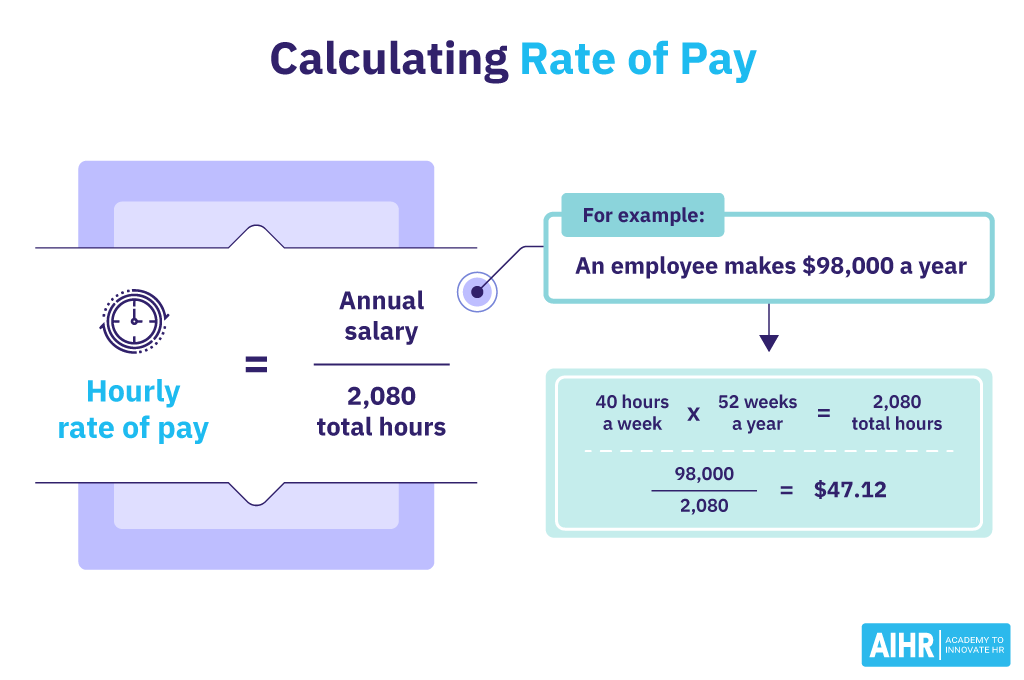Rate of Pay
What does rate of pay mean?
The term “rate of pay” refers to the amount of money an employee should receive within a designated time frame, such as hourly, weekly, or monthly. This compensation may comprise wages, commissions, bonuses, and other entitled benefits. Additionally, if the employee exceeds 40 working hours per week, they may qualify for overtime pay, typically set at one and a half times their regular pay rate.
How does rate of pay work?
The rate of pay is determined by the Fair Labor Standards Act (FLSA), a regulatory law. Under this act, the regular rate per hour of an employee’s compensation is established.
Employers and HR departments often rely on the regular rate of pay to calculate appropriate overtime wages for employees. It’s important to note that the regular rate of pay may vary if the employee receives additional compensation, such as bonuses.
The rate of pay is influenced by many factors, such as:
1. FLSA regulations
In the US, the Fair Labor Standards Act (FLSA) is the governing body regulating the pay rate. As such, any policies formed by the government or new regulations set up by the FLSA can significantly impact employee wages and salaries. For example, wages and salaries cannot be set below the level prescribed by the government. Additionally, employers are obligated to comply with laws governing hours of work, equal pay requirements, allowances, and payment of bonuses.
It’s important to note that the regulations stipulated by the FLSA may vary by jurisdiction, such as country or state. Furthermore, different industries may have varying qualifications, skills requirements, and levels of experience, which also affect pay rates within those industries.
Demand and supply forces within a specific industry further contribute to determining wage rates. Industries with high demand and limited supply typically offer higher rates of pay compared to those with an abundance of talent.
2. Marketing conditions
Various market conditions, such as competition for talent, can impact the wage level. Moreover, the prevailing competition within the industry for the product can influence wages.
Employers with highly sought-after products may consider increasing wages to align with the net contributions made by workers to the company’s overall output.
3. Individual performance
Employers prioritize productivity and performance when evaluating employees. High-performing individuals often receive better compensation, particularly in fields where their contributions directly impact the company’s profitability.
As productivity is a crucial aspect of a company’s operations, individual performance plays a significant role in determining wage rates. Other factors considered here include;
- The worker’s knowledge and skills
- Educational qualifications
- Knowledge and years of experience
4. Minimum wage laws
Different countries have a minimum wage cap. These laws establish the minimum amount that employers can pay their employees.
Common elements related to rate of pay
When understanding how the FLSA regulates the rate of pay, you should also look at the common elements related to the rate of pay. These are:
1. Hourly rate
Hourly wages are typically provided to workers who are unskilled, semi-skilled, temporary, part-time, or on a contract basis. Industries such as hospitality, retail, and construction commonly employ workers on an hourly wage basis.
Workers receiving hourly wages may also be eligible for overtime pay, which is earned when working beyond the contracted hours. It is important to adhere to local minimum wage laws, even when paying hourly rates.
Salaries are typically provided to full-time or skilled employees, including those in management positions, reflecting an organization’s long-term commitment to its employees. Professions such as teachers, accountants, and doctors often receive a salary.
2. Commission
A commission is a standard arrangement for employees in sales positions. It is determined by reaching a pre-set target or quota. The commission amount increases as the quota is exceeded. Additionally, commission rates are influenced by factors such as revenue and profit margins.
Employees generally have the option to work strictly on a commission basis or to receive a combination of a base salary and commission.
3. Piece-rate
The piece-rate payment system is distinct in that employers pay based on the number of units or items of work created, as opposed to a salary or hourly wage. This approach is particularly effective in industries like design as it incentivizes employees to boost productivity.
Under the piece-rate system, employees’ earnings are directly tied to their output in terms of products and services. It’s important to note that these factors can impact the overall rate of pay, and it’s crucial to consider the legislation specific to each location.
How to calculate rate of pay
Understanding how to calculate the rate of pay is crucial for various reasons. By familiarizing yourself with the factors and methods involved, you can accurately determine the rate of pay.
Alongside the payment methods mentioned, there are other elements to consider during the calculation process:
1. Gross vs. net pay
Gross pay is the total amount earned before deductions. Gross pay includes overtime pay, holiday pay and bonuses.
Net pay is the amount received after deductions, such as taxes and other withholdings. The net pay received depends on taxation laws and employee deductibles like pension contributions.

2. Shift differentials
Shift differentials are an important factor when calculating the rate of pay. It is crucial to distinguish between shift differentials and overtime pay, as they are often mistakenly believed to be the same.
A shift differential refers to additional compensation provided to employees who work outside their regular work hours. These shifts are typically less desirable, such as graveyard or weekend shifts. The purpose of a shift differential is to incentivize employees to take up these shifts by offering them a higher hourly rate.
It’s worth noting that shift differentials are not legally required, but rather offered to all employees who work these specified hours.
By understanding the concept of shift differentials, you can accurately calculate the rate of pay for different employees based on various elements.
3. Hourly rate
You can calculate the hourly rate of salaried employees by dividing their annual income by the total number of regular hours worked.
So if an employee makes $98,000 a year, you should divide that by the number of hours worked in the year to get the hourly rate:
40 hours a week x 52 weeks a year = 2,080 total hour
98,000 / 2,080 = $47.12
So the hourly rate is $47.12.
4. Salary
To calculate earnings, you should multiply the hourly rate by the number of regular hours worked:
Hourly rate x the number of hours worked = Salary
If an employee is earning $32 an hour and works 40 hours during the week, their weekly earnings will be as follows:
$32 x 40 = $1,280
5. Overtime pay
If the employee is eligible for overtime, you need to include that too. Typically, overtime pay rate is 1.5 times the usual rate.
Let’s say the same employee as above works 3 hours above their standard 40 hours. Then they would be entitled to three hours of overtime pay. First, you need to calculate the overtime pay rate, which is:
40 x 1.5 = $60
$60 x 3 hours = $180
Besides the $1,280, the employee would also be eligible for $180 in overtime pay.
6. Piece rate and commission
Piece rate and commissions are often agreed upon before employment commences and vary widely depending on the industry and market factors. You can calculate either of them by dividing the pay received by the number of pieces delivered or the number of items sold above the quota (for commission).
HR strategies for determining rate of pay
HR strategies for determining the rate of pay involve considering various factors and striking a balance between attracting top talent and protecting organizational interests. Some effective strategies to determine the rate of pay include:
- Employee evaluation: Evaluating employees’ performance and their contribution to the company’s success is a reliable method to determine pay. This approach focuses on rewarding employees based on their impact.
- Market research: The job market is dynamic, with changing demands and rates. Consistently monitoring market trends allows HRs to be aware of prevailing rates and calculate appropriate pay for employees in their organization.
By employing these strategies, HRs can ensure competitive pay rates that align with both employee performance and market realities.







